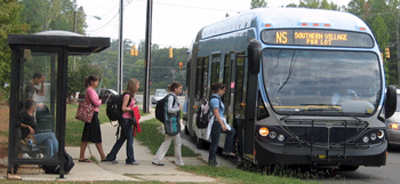The May 2017 column in the Chapel Hill News by Matt Bailey and OrangePolitics Editors Jason Baker and Molly De Marco explores how transit-oriented development can address the affordable housing crisis in our community. What are your thoughts? Read the column below:

Three of the biggest challenges facing Chapel Hill are providing affordable housing for people of modest incomes, bringing back tax-paying private-sector employers, and reducing the high cost of providing local government services that has resulted from policies encouraging suburban sprawl.
Transit-oriented development is a proven way to address all three of these challenges.
A transit-oriented development, or TOD, is a community with homes, offices, shops and restaurants, and public recreation space, integrated into a walkable neighborhood and located within a half-mile of quality public transportation, typically light rail or commuter rail. TODs improve people’s health, since their residents naturally spend more time in their daily routines walking and less time sitting in traffic. TODs also improve the environment by reducing carbon emissions through reductions in car use. Transit-oriented development, however, is also crucial to solving several of Chapel Hill’s unique and systemic challenges:
TOD provides housing options that residents with lower incomes can afford. First, transit-oriented development provides the opportunity to create subsidized housing that traditional single-family subdivisions simply don’t provide, because with TOD come opportunities for municipalities to partner with developers to obtain those subsidies, something that is not available in traditional subdivisions. TOD also helps families of modest incomes save money because it provides access to grocery stores, recreation, and most importantly, employment centers, without the need to own a car. Walking is free and transit passes cost a lot less than car payments, insurance, gas, and auto repairs, putting money back in family’s pockets.
TOD attracts top-tier private sector employers. Half a century ago, office employees wanted offices in secluded bucolic environments. That’s why Blue Cross and Blue Shield of North Carolina built their iconic modernist rhombus on Chapel Hill’s edge in what was, at the time, the middle of nowhere. Unlike yesterday’s employees, who saw cars as a force of freedom, today’s young professionals view driving as an expensive burden. They also want to be in the middle of the action, not isolated from it. Top-tier employers are actively seeking office space in transit-oriented developments, which offer employees attractive alternatives to driving and environments with dining and recreational opportunities steps from their offices. With light rail access to three major universities, Chapel Hill is poised to bring major private sector employers back to town if our community plans now for TOD.
TOD lowers costs to provide local government services. From road construction and maintenance to water and sewer service to fire and police protection and waste and recycling pickup, the most expensive form of housing for local governments is the single-family suburban subdivision. The environmental think tank Sustainable Prosperity estimates that the typical sprawling suburban subdivision costs municipalities almost two and a half times what denser-style pedestrian-oriented development TODs would cost. Chapel Hill can spend more on parks, libraries and other quality-of-life amenities when the town isn’t spending to support more suburban sprawl.
With the Durham-Orange Light Rail Transit project now officially moving forward, Chapel Hill is on track to have a fast, efficient way to travel to and from UNC and UNC Hospitals, our community’s major employment hubs. We have an opportunity to reap even more rewards when we begin planning now to create new places for people to live, work, shop and enjoy life that take full advantage of the opportunity to live life fully in a place where driving isn’t necessary. Town leaders should begin planning now for transit-oriented development in the N.C.-54 and Old Durham Road corridors. It’s our best opportunity to expand affordable housing, bring back taxpaying employers and reduce the high cost of suburban sprawl.



Comments
TOD?
Please. Branding something TOD does not make it so.
Light Rail and TOD might create more efficient land use patterns and create a balanced set of transportation choices where automobiles coexist alongside other options, IF TOD with light rail are well designed and deployed, but the jury is yet to be instructed in that trial.
A look at existing projects that claim transit-orientation reveals that although many projects have been quick to embrace the term, most have fallen far short of promises. Take for instance Meadowmont, the showcase for TOD in Chapel Hill. Meadowmont rejected DOLRT using the Little Creek watershed crossing as a reason. The fact this wasn’t already resolved highlights poor planning, how was Meadowmont allowed to proceed under the promise of TOD without a full discussion with the Army Corps of Engineers? Exactly why did Chapel Hill move the route away from preferred Meadowmont DOLRT corridor to the other side NC54 highway and at the same time permit construction of a car wash within 1/2 mile of Woodmont station which is TOD development? Successful TOD requires coordinated planning and zoning between the two cities and counties that is definitely not in evidence.
Another reoccurring problem with TOD development is the abandonment of existing physical infrastructure and building stock. That depreciation is wasteful from an economic and environmental standpoint and contributes to economic decline in the areas left behind. Large parts of the 15-501 corridor are one such example, brought to you again by questionable route choices and assumptions.
DOLRT not only depreciates an existing corridor, but it creates a new one in, and encourages dense development near, two critical watersheds; Little Creek and New Hope. By routing DOLRT in this way, the increase of impervious surfaces and destruction of wetlands further reduces the rate of aquifer replenishment and contributes greatly to the degradation of downstream Jordan Lake water quality. Replacement of tree cover with asphalt and buildings creates urban heat islands that raise temperatures and accelerate the formation of smog and ozone. Advocates will tell you that this route will reduce sprawl, but that claim is just not convincing based on the evidence.
Affordable housing begins with affordable neighborhoods. Despite our local leaders attempt to use the empty promise of increased affordable housing as a justification for DOLRT, affordability remains a distant wish. History shows local government reliably accept less than 15% affordable housing while taking cover in state laws that remove tools to keep rents affordable. Since economics dissuade developers from building the mix necessary to eliminate the need for a car entirely and land costs have and will continue to skyrocket, any cost benefit claim to not owning a car is quickly negated. Until then, the historical fact is that low wealth people and families will be economically incentivized to move further away, increasing sprawl.
The less promising term Transit Related Development is more appropriate. Transit stations lack a mix of land uses. Moreover, many DOLRT station designs fall short of yielding the full range of potential benefits because most of the stations in Orange County are on tax exempt UNC property. With little to no private investment, they constitute a Transit University Related Development rather than a true integration of land use and transit. This results in a project that does not make up a balanced neighborhood where people can accomplish daily tasks without a car.
Simply calling something TOD is not enough. What scale of development is necessary to make TOD work in different contexts, including stations on University property? How can a project strike a balance between providing adequate parking to remain economically viable without allowing it to detract from the pedestrian and transit orientation of the neighborhood? How much affordable retail and of what type is needed to serve the resident population and workers so that they are not car-dependent? How will TOD efforts integrate with Mobility as a Service (MaaS)? What are the plans for the 3.3 billion dollar investment when it is prematurely obsoleted by the whole range of disruptive transit services that do a far better job of getting people point to point? These are the kinds of questions to which GoTriangle planners have had few answers, instead they arrange glossy marketing presentations for residents who do not know what questions to ask. They call it “outreach” and tick the box on the FTA form. "Mission accomplished".
Some may agree and others might find it challenging, but what I find missing from GoTriangle’s rhetoric about DOLRT is a clear notion of the desirable functional attributes of the project with a plan to achieve them and therefore a straightforward way to measure success.
People are celebrating the claims of TOD in the face of overwhelming changes in culture and technology are risking enormous amounts of taxpayer money. Do not let ideology declare success and move on without following through or taking responsibility.